Donggung Palace and Wolji Pond
Donggung Palace and Wolji Pond, formerly known as Anapji, is an artificial pond in Gyeongju National Park, South Korea. It was part of the palace complex of ancient Silla (57 BCE – 935 CE). It was constructed by order of King Munmu in 674 CE. The pond is situated at the northeast edge of the Banwolseong palace site, in central Gyeongju. It is an oval shape; 200m from east to west and 180m from north to south. It contains three small islands.[1]
| Donggung Palace and Wolji Pond | |
|---|---|
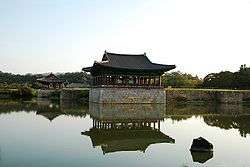 | |
| Location | Gyeongju National Park |
| Coordinates | 35°50′4.63″N 129°13′37.61″E |
| Type | Artificial pond |
| Basin countries | South Korea |
| Islands | 3 |
| Korean name | |
| Hangul | |
|---|---|
| Hanja | |
| Revised Romanization | Anapji |
| McCune–Reischauer | Anapchi |
History
Anapji was originally located near the palace of Silla called Banwolseong. It is written in Samguk Sagi: "During the era of King Munmu, a new pond was made in the palace and flowers and birds flourished in this pond". There is also mention of a royal reception held by King Gyeongsun in 931, when Silla was already crumbling. After the fall of Silla, the pond fell into disrepair for many centuries. The name Anapji appears in the 16th century Joseon era document Augmented Survey of the Geography of Korea (hangul:동국여지승람, hanja:東國輿地勝覽) with the explanation that King Munmu made the pond with Taoist aesthetics.[2]
Renovation and excavation of relics
As part of the renovation project of historic sites in Gyeongju, Anapji was dredged and rebuilt in 1974. The long-term excavation project from March 1975 to December 1986 released a large number of relics from the pond. Research revealed that the pond had been surrounded by stone walls, and that 5 buildings had been standing on the pond's west to south sides. Waterway systems were also detected. Almost 33,000 pieces of historic relics were excavated from the site. An abundance of unique and extraordinarily designed roof tiles, architectural materials, pottery, gilt bronze figures of Buddha, jewelry, accessories and other everyday items were discovered, offering an insight to Buddhist art and everyday life in Silla.[2]
Tourist destination
Anapji is currently allotted in Inwang-dong, Gyeongju and is part of Gyeongju National Park. Approximately 730 relics are on display at the Anapji Exhibition Hall, the special gallery of the Gyeongju National Museum. The site of Imhaejeon is also a part of the grounds, the most important building on the property and the structure used as the crown prince’s palace. While some sites have been restored others have been left in the natural form.[3][4]
Gallery
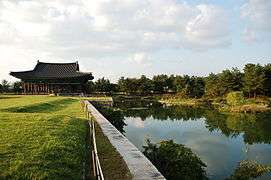
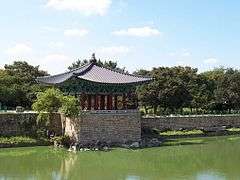
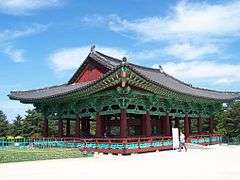
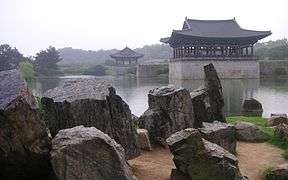 Anap Pond facing the Banwolseong palace site
Anap Pond facing the Banwolseong palace site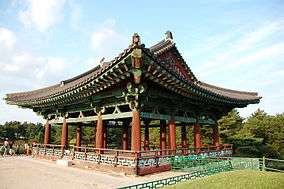 A reconstructed pavilion at Anapji lake.
A reconstructed pavilion at Anapji lake.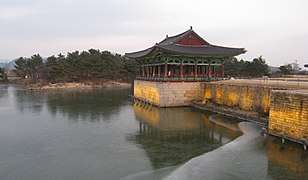
- Anapji at night
- Anapji at night
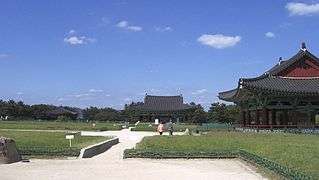 From the entrance
From the entrance
See also
- Silla
- List of Korea-related topics
- List of South Korean tourist attractions
- History of Korea
- Banwolseong
References
- 안압지 (in Korean). Doosan Encyclopedia. Retrieved 2014-03-21.
- 안압지 (in Korean). Britannica Korea via Daum. Archived from the original on 2014-03-21. Retrieved 2014-03-21.
- Anapji Pond at official site of Korea Tourism Organization
- (in Korean) Anapji exhibition hall at Doosan Encyclopedia
External links
| Wikimedia Commons has media related to Donggung Palace and Wolji Pond. |